Hello All,
BLUF: This is a longer post asking for some advice and constructive criticism.
I haven't been baking for very long and I'm working my way through the recipes in Flour, Water, Salt, and Yeast. My first batch (pictures below) tasted great but had a tight crumb and not so great rise. I am 99% positive this is due to over-proofing . In addition, I still need work on shaping but I think a lot of practice will eventually cure that (maybe). I also had some issues with the transfer to the dutch over from the countertop (more practice needed). This was a 75% whole wheat to 25% AP (1000g total and 800g water). It had a five hour ferment and about 14 hours in the fridge. I baked it at 450 (or as close as I could my oven to 450) for 55-60 minutes. I think I could have gone at least 5-10 minutes longer based on the coloring on the outside and the moistness inside. I really enjoyed the flavor and it was, by my wife's admission, my best bread ever. This may not sound like high praise but trust me, she does not pull any punches. I try to remind her that in the kitchen of an aspiring baker, it's ok to sugar coat a few things.
My second batch, my wife requested I make one in a loaf pan and the second in the dutch oven. This time I did a 40% whole wheat and 60% AP flour (1000g total and 800g of water). This one felt better. When I was ready for shaping, I thought I had shaped at the right time. The shaping still needs work but went better and my rolling on the countertop needs work. I lose the top and bottom to easily. The proofing was timed much better per the finger dent test. I baked for 60-65 minutes this time. It sprang in the oven much better but I still don't get any splitting. I used some foil to try and keep the steam in the loaf pan and it made for a better crust but it stuck to the top of the bread because I didn't expect. On positive note, best sandwich bread I've ever made! Held together amazingly.
I am still not entirely sure what is right or wrong since I'm still learning (reading through the handbook now) but I really enjoy it and can't wait to make the next batch this weekend. Questions I have so far:
- Should the crumb feel tacky or be moist after slicing? Should it be dry throughout? Looking at other photos on here, I think I need a longer bake.
- If my bread isn't cracking open on it's own is that because I'm not making a score or a timing issue?
- My bread always has a denser crumb on the bottom. I can't fix this I've tried hotter over, a pizza stone under the loaf pan, I was hoping that the dutch oven would fix this, but still nothing.
- Since I can't get my oven up to 450, I'm going to try for a 70-75 minute bake this next time. Any advice on baking time? I figure I'll just need more experimentation.
- It seems like my bread should still be rising more, at least enough to account for an open crumb. Is this a timing issue, a gluten development issue, or a shaping issue?
I know this is long so if anyone makes it this far, thanks a million for taking the time. I appreciate any advice or answers.
Mike
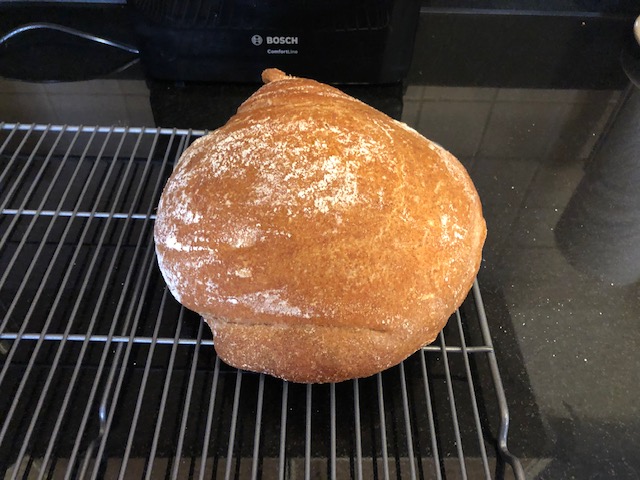
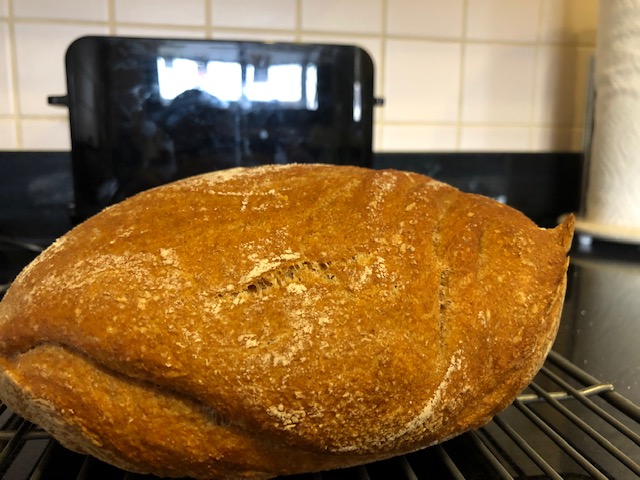
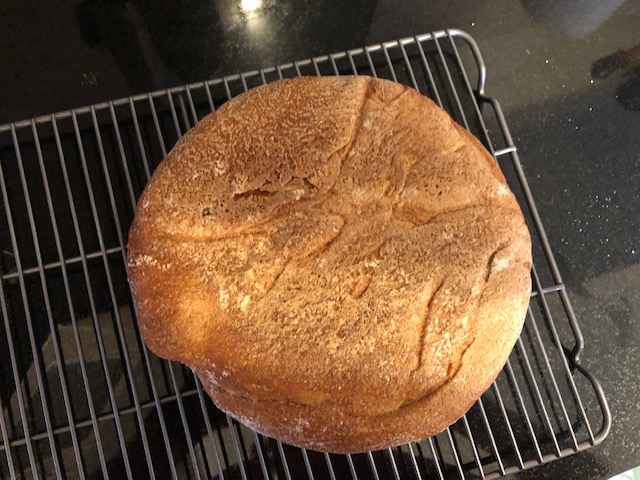
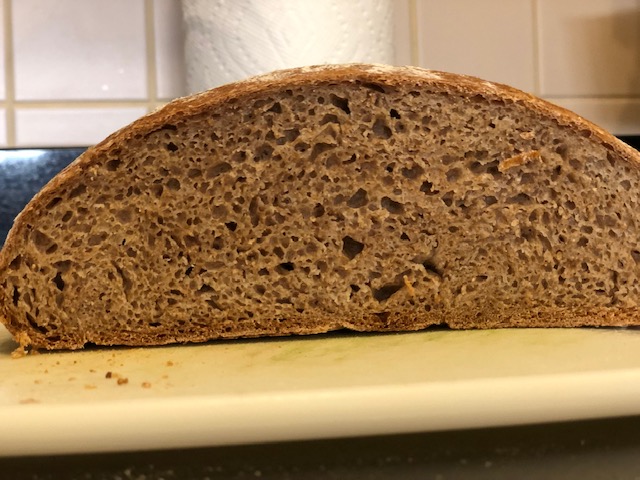

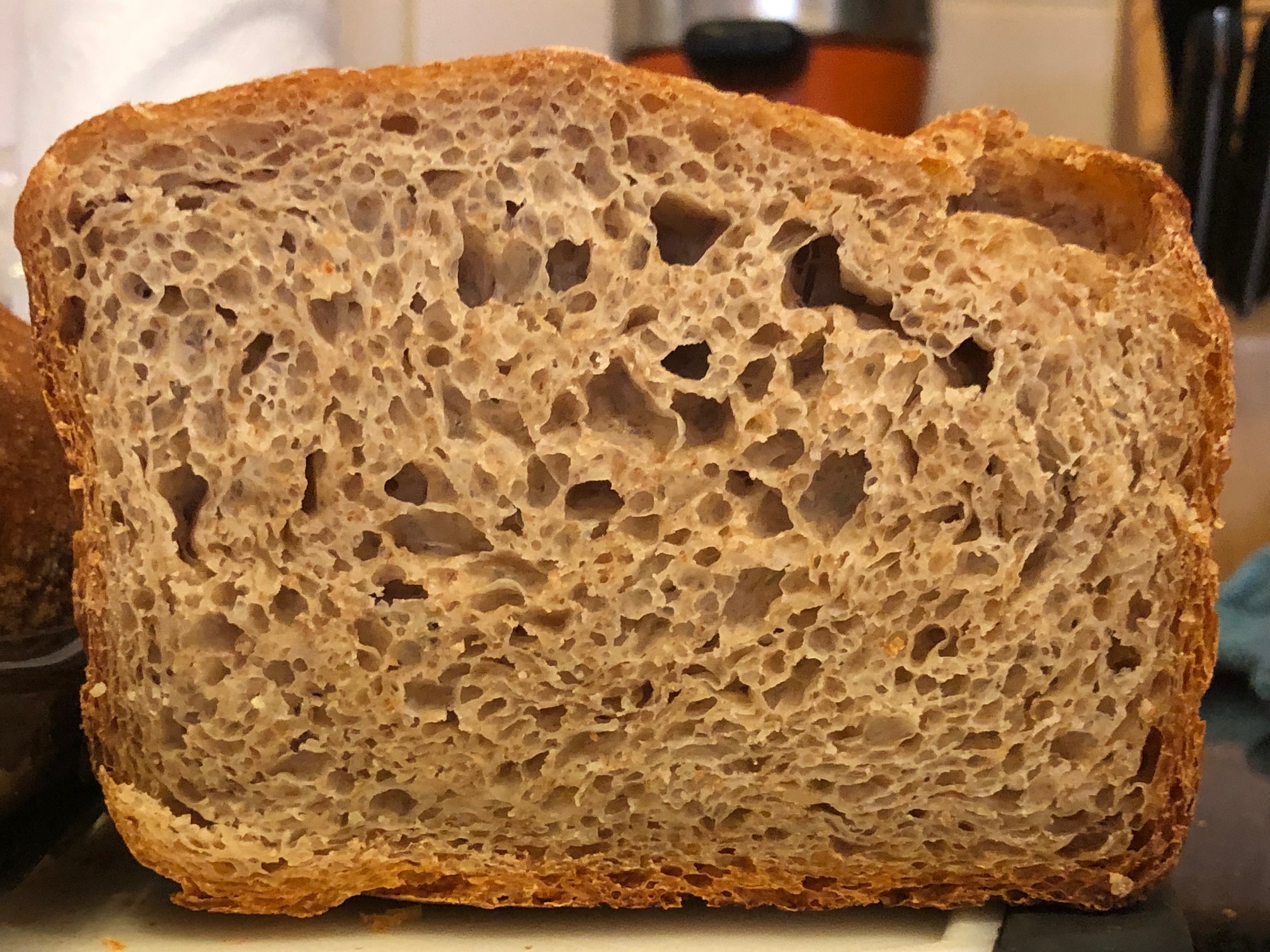
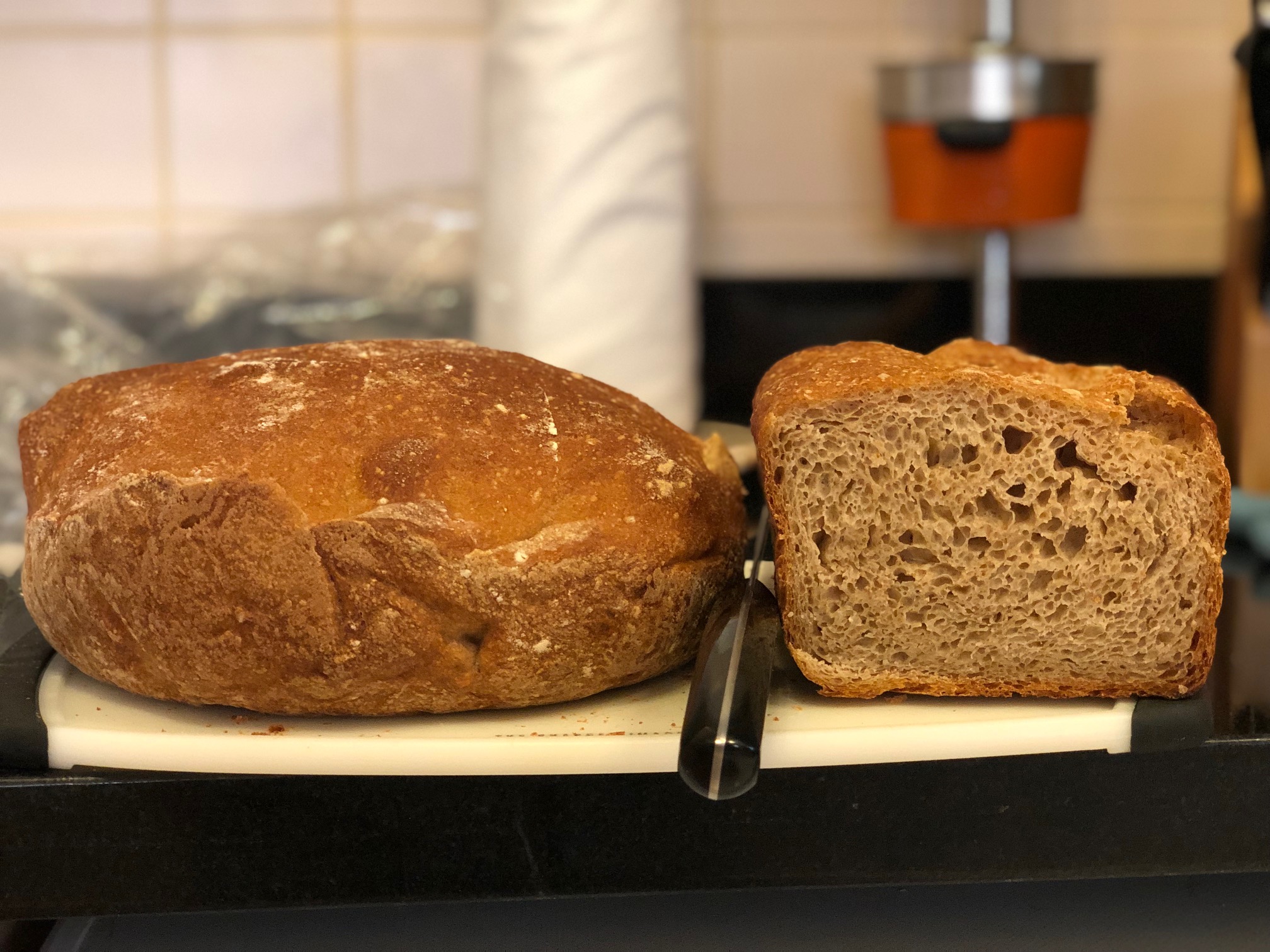
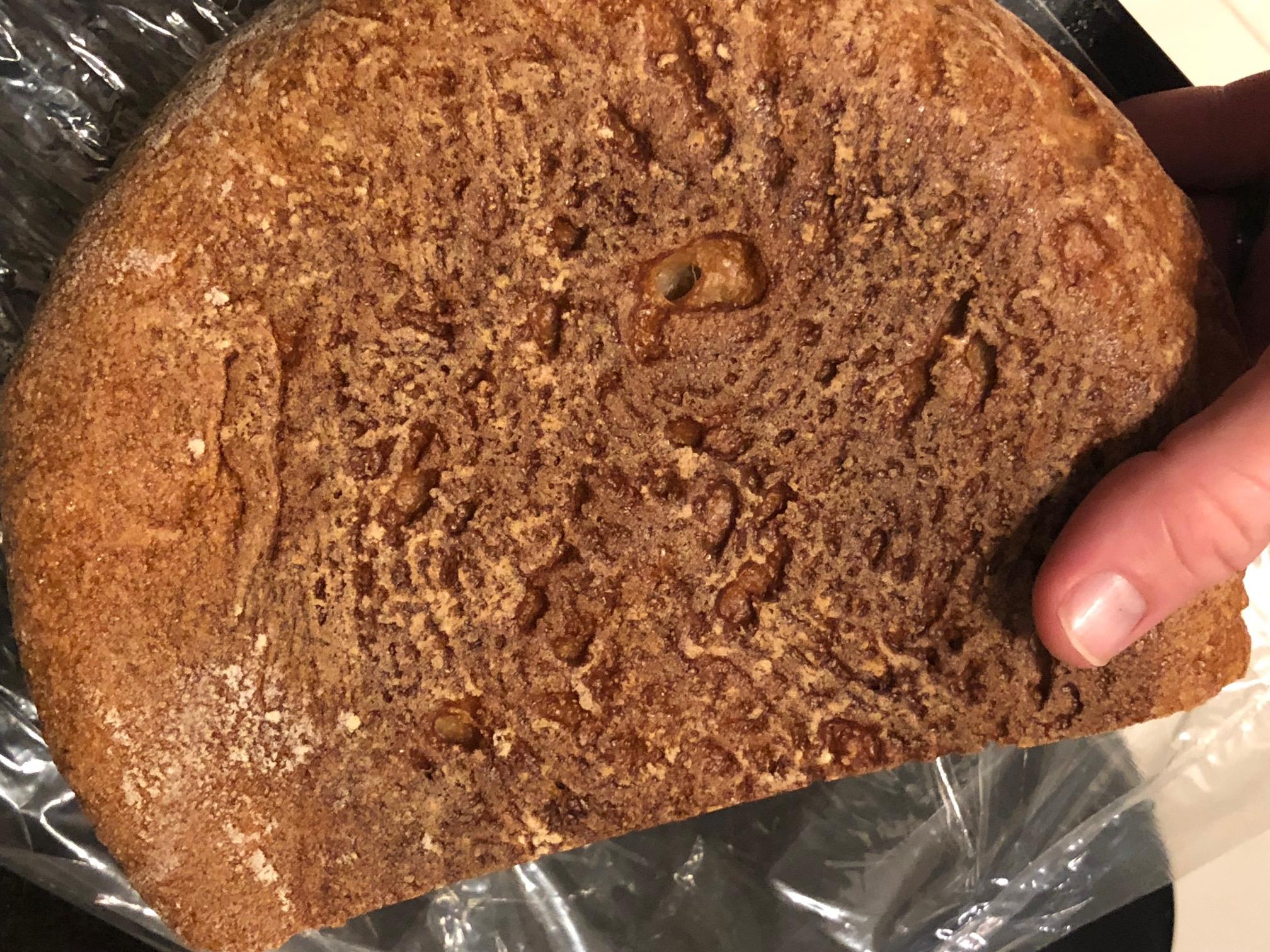

First of all: your breads and the crumb look already amazing!
I try to answer most of your questions. If you already practise any of these following tips, please forgive me. Even though I'm fairly new to baking bread too, I can already tell (or at least guess well) what some of the problems might be, based on personal experience and what I read :)
- Whole wheat breads always tend to be a little denser and fragile since the whole wheat flour contains more particles that can damage the gluten structure. When working with whole wheat, be a little more gentle when handling the dough. Probably you already noticed some differences and improvements when you dropped the whole wheat percentage.
You can also do an autolyse (mix only the flour and water and let it sit for anything between 20min. and 2h, then add other ingredients), which improves gluten structure and dough strength, especially when working with whole wheat.
- 80% is pretty high hydration and in combination with whole wheat, its likely to come out a little denser. I would drop it down to at least 70%, maybe even 65% (especially when working with sourdough).
- Pre-heat your dutch oven too (and I mean like half an hour at least), so the bread gets even heat from all sides.
- Scoring is - in my opinion - imperative, I yet have to find a bread that doesn't need it. It creates a strategic vent for any excess air to escape and helps the bread to rise more evenly and beautifully.
- I don't know if you do this already, but you need to let your bread cool for at least an hour after baking (with such big breads two would be even better). That way the moisture and and aromas have time to spread evenly throughout the bread and it should help with the tackiness. Then again whole wheat breads are usually a little stickier, so up to a certain moistness its normal. Something to do with pentosans I believe (might need to fact-check that). Also cool it in a well ventilated, cool area - keeps the crust crispy.
I hope I could bring a little more light into this :) You are already doing really well! Basically, as long as it tastes good and eats well, it's already a success in my eyes.
First of all thank you for the reply and all the great advice.
- Ahhh, I'll keep that in mind and adjust my expectations. I probably did fold more vigorously than kneaded (get it). I got excited when it was shaping up and I could see the gluten forming. I'll take it slower and be more gentle. Yes, I definitely felt like the structure of the bread during the folding, shaping, and proofing was much better.
- I did to an autolyse but only for about 30 minutes. I am seeing some longer autolyse times on the forums here and I will experiment with that a bit.
- That's a great idea. I'll start at 70% and work my way back up to 80% just to see what differences come about.
- I live in Bahrain and the oven isn't the largest or fastest to preheat. I always keep the dutch oven in there and it will take over 45 minutes to get the oven to 425-ish. I still haven't seen it hit the 450 yet. I keep adding time with each bake and this time I'm going to add another 5-10. I am taking the lid off at the 30 minute mark and increasing the time without the lid. Do you think I should keep the lid on a little longer?
- Then I shall score batch three and see what comes up!
- Ahh, in Flour, Water, Salt, and Yeast he said you need to wait at least 20 minutes. In previous loaves I had waited 2-3 hours. I'll go back that. Thanks.
- Thanks a million! So far I'm super happy with the taste and how well it is outperforming the loaves we are used to buying. I'm excited to try out some of the tips you sent my way.
Happy to help!
Autolyse needs at least 15 min. I believe to activate (something with alpha-amylase, enzymes and stuff, can't remember exactly)...so 30 min. is great, but anything up to two hours should be fine. The great advantage is less mixing, thus oxidizing the dough less and preserving flavor.
You can take off the lid already after 15-20 min. Then the bake also should take less time. If you leave it on for too long, it might do something to the crust since you keep trapping the steam. The first 10-15 min. are there to puff the bread and set the crust. The steam you trap by keeping the lid on keeps the temperature down, thus increasing the time the yeast and enzymes can work and produces gas before they die of heat. After that you take the lid off, let the steam escape and bake until the crust is nice and deep amber brown.
Can't remember the exact times, need to look through my book, there are also graphs about enzyme activity during baking, why everything is happening during kneading, proofing and baking and how to troubleshoot it.
I mean, there is nothing wrong with eating the bread as soon as it's not too hot anymore :D But the extra waiting time pays off. I believe it also has something to do with the food being closer to body temperature, thus tasting better...there is a whole science behind that.
Which book discusses the enzyme activity? Worth a read? I'll definitely pull the lid off early and see how that affects my bake.
The book is called Advanced Bread and Pastry (by Michel Suas, founder of San Francisco Baking Institute), you can get it for about 60-70$. It's absolutely amazing, but its a very heavy read (both literally and figuratively).
It's about 1000 pages and maybe about 300 of them are on bread alone (the others are about quick breads, cakes, chocolate, pastry doughs etc.). It explains in great detail all the roles of ingredients and processes of shaping, mixing, baking, why you do what you do, what happens when you change something, troubleshooting etc.
It's likely targeted more towards artisan bakeries (judging from the amounts in recipes) and many might call it overkill, but if you invest the time and read at least the bread chapters, that alone is worth the money since it gives you so much better understanding of every step of the craft.
Also 10% protein is quite on the edge of how little there should be in your flour, regardless of organic or not. I mean it will work, but 12-13% is in my experience better for many reason (stronger gluten structure, less mixing time, better flavor).
I just realized something. With the first batch I made, the AP flour was Dove's Farm Organic Plain White Flour and it says 10g of protein per 100g. The second batch, which did have more AP was Pilsbury I believe. I wonder if I should try it with the Dove's Farm Organic Strong White Bread Flour. So many things to experiment with and try, so little time.